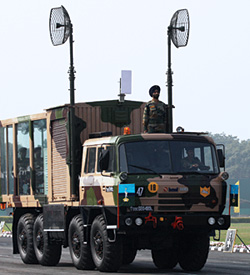INDIAN ARMED FORCES CHIEFS ON OUR RELENTLESS AND FOCUSED PUBLISHING EFFORTS

The insightful articles, inspiring narrations and analytical perspectives presented by the Editorial Team, establish an alluring connect with the reader. My compliments and best wishes to SP Guide Publications.

"Over the past 60 years, the growth of SP Guide Publications has mirrored the rising stature of Indian Navy. Its well-researched and informative magazines on Defence and Aerospace sector have served to shape an educated opinion of our military personnel, policy makers and the public alike. I wish SP's Publication team continued success, fair winds and following seas in all future endeavour!"

Since, its inception in 1964, SP Guide Publications has consistently demonstrated commitment to high-quality journalism in the aerospace and defence sectors, earning a well-deserved reputation as Asia's largest media house in this domain. I wish SP Guide Publications continued success in its pursuit of excellence.
- Appointments Committee of Cabinet approves one-month extension in service of Chief of the Army Staff
- Admiral Dinesh K. Tripathi assumes Command of the Indian Navy as 26th Chief of the Naval Staff
- Prime Minister witnesses 'Bharat Shakti' – a Tri-Services Firing and Manoeuvre Exercise in Pokhran, Rajasthan
- Interim Defence Budget 2024-25 — An Analysis
- Union Defence budget 2024
- Prime Minister Modi Commemorates Indian Navy Day in a Grand Ceremony
Replace policy of best price with best technology

Discrimination between the private industry and the public sector is prominent but not being rectified where individual fiscal benefits may well be axiomatic. No one asks why we cannot even produce state-ofthe-art assault rifles, carbines, bullet proof jackets, night vision devices.
The recent media leak of the Army Chief’s letter to Prime Minister and various reports including the Tatra episode highlighted some vital issues: first, our defence procurement is on adhoc basis; second, defence procurement prioritisation is not based on any national security strategy; third, 70 per cent of defence requirements are imported still imported; fourth, the defence procurement procedure (DPP) remains bureaucratic and timeconsuming; fifth, investments in defence R&D are miniscule; sixth, little government focus on defence indigenissation; seventh, private industry participation is largely through DRDO and PSUs; eighth, inadequate defence modernisation funds and periodic surrenders from defence budget; ninth, corruption in procurement makes military pay more for smaller returns in meagre defence budget; tenth, DRDO and PSUs have become business empires with little accountability that government is unable to correct, and eleventh, inadequacy of defence structures and reforms adversely affects matters military including defence procurement.
At the base of all this lies lack of political attention, absence of civilian expertise (some even itinerant and ill-informed) and bureaucratic infighting. Trefor Moss wrote in The Diplomat of March 25, 2012, “Army Chief General V.K. Singh…suggested wearily that “the procurement game is a version of snakes and ladders where there is no ladder but only snakes, and if the snakes bite you somewhere, the whole thing comes back to zero.” His exasperation centred on army’s efforts, initiated 10 years ago, to buy new artillery; the process has just resulted in the blacklisting of six foreign defence contractors, but as yet, no new guns.”
Discrimination between the private industry and the public sector is prominent but not being rectified where individual fiscal benefits may well be axiomatic. No one asks why we cannot even produce state-of-theart assault rifles, carbines, bullet proof jackets, night vision devices. Why did it take 15 years to produce the INSAS rifle that still has defects? Why does the LCA produced after decades of delay still has 40 percent imported parts including engine? Little wonder that Manibhai Naik wrote an open letter to the Prime Minister saying, “Defence Production (MoD) Joint Secretaries and Secretaries of Defence Ministry are on the Boards of all PSUs – sickest of sick units you can think of who cannot take out one conventional submarine in 15 years now with the result that the gap is widening between us and China and bulk of the time we resort to imports out of no choice. The defence industry which could have really flowered around very high technological development and taken India to the next and next level of technological achievement and excellence is not happening”. Where is the government’s indigenisation road map? Is it not a shame that we do not have a single chip fabrication plant? 100 per cent computer parts and 90 per cent of even BSNL equipment comes from China and we do not have the capacity to test leave aside treat them for Trojans, bugs, malware. When it takes us 15 years only to develop an assault rifle despite 17 weapons imported from 11 countries at the time of commencing development, larger weapon system taking decades to design, develop, test and induct, handling will only be possible through a rolling Development and Acquisition Board (DAB) grouping the military, DRDO, public and private industry, DGQA, academia, scientists/IITs, management gurus, legal and financial experts with adequate financing and assured long term continuity of board members.
As for defence procurement, the entire procurement process including the working and finalisation of the General Staff Qualitative Requirements (GSQR) which takes considerable time must be made totally online and time bound. The DAB should be an autonomous body with government’s role restricted to ‘only’ policy issues. It should be the responsibility of the DAB to fix targets and accountability, ensuring transparency and aim for best technology. We must replace the policy of ‘best price’ with ‘best technology’
The views expressed herein are the personal views of the author.





